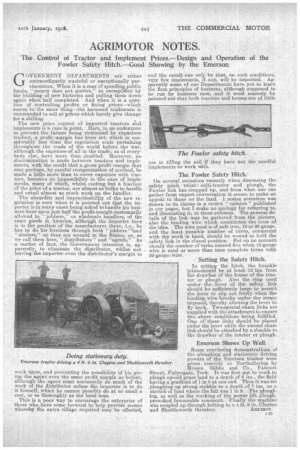AGRIMOTOR NOTES.
Page 19

If you've noticed an error in this article please click here to report it so we can fix it.
The Control of Tractor and implement Prices.—Design and Operation of the Fowler Safety Hitch.—Good Showing by the Emerson
GOVERNMENT DEPARTMENTS are either extraordinarily wasteful or exceptionally parsimonious. When it is a ease of spending public funds; " money does not matter," as exemplified by the building of new factories and pulling them downagain when half completed. And when it is a question of controlling profits or fixing prices—which. comes to the same thing—the harassed tradesman is commanded to sell at prices which barely give change for a shilling. 4 The new price control of imported tractors and implements is a case in point. Here, in an endeavour to prevent the farmer being victimised by rapacious traders, a profit 'margin has been set, which is considerably less than the regulation scale pertaining throughout the trade of the world before the war, although the expenses of all in the trade., as of everybody else, have more than doubled. Moreover, no discriminatign is made between tractors and implements, with the result that a gross profit margin that may perhaps, by careful reorganization of method, be made a little more than to cover expenses with tractors, becomes an impossibility in the ease of implements, 'many of which, Whilst costing but a fraction of the price of a tractor, are almost as bulky to handle and entail ahnost as much work on the handler.
The absurdity and impracticability of the new regulation is seen when it is pointed out that the importer is in many cases being asked to handle his business here upon just half the profit-margin customarily allowed to jobbers," or wholesale handlers, of the same goods in America, although the importer. here is in the position of the manufacturer there, i.e., he has to do his business through both "jobbers "land " dealers," as they are termed in the States, cram we call them here, "distributors" and "agents.". As a matter of fact, the Government intention is apparently, to eliminate the distributor, whilst nOt leaving the importer even the distributor's margin to
work upon, and preventing the possibility Of his giving the agent even the same profit margin as before, although the .agent must necessarily do much of the Work of the distributor unless the importer is to do it himself, which he cannot possibly do at so small a cost, or so thoroughly as the local man, This is a poor way to encourage the enterprise of those who have come forward to help provide means whereby the extra tillage required may he effected, and the result can only be that, on such conditions, very few implements, if any, will be imported. Apparently some of our Departments have yet to learn the first principles of business, although supposed to be run by business men, and it need scarcely be pointed out that both tractors and horses are of little use in tilling the soil if they have not the needful implements to work with.
The Fowler Safety Hitch.
On several occasions recently when discussing the safety hitch twixta culti-tractor and plough, the Fowler link ha,s cropped up, and from what one cars gather from expert conversation it seems to make an appeal to those on the land. I notice attention was drawn to its claims in a recent " opinion " published in our pages, but I make no apology for referring to, and illustrating it, in these columns. The general details of the link may be gatheredfrom the picture, also the binding wire which constitutes the crux of the idea. The wire used is of soft iron, 18 or 20 gauge, and the least possible number of turns, consistent with the work in hand, should he wound to hold the safety link in the closed position. But on no account should the number of turns exceed five when 18-gauge wire is used or more than nine complete turns with 20-gauge, wire.
• Setting the Safety Hitch.
In setting the hitch, the knuckle jointashould be at least 12 Ms, from the drawbar of the frame of the tractor or plough. Also the ring used under the. lever of the safety link should be sufficiently large to permit the lever to slip out freely when the binding wire breaks under the -strain imposed, thereby allowing the lever to fly back. Twosspecial-chain links are supplied' with the attachment to ensure the above conditions being fulfilled. One oV these links should be placed under th.e lever while the second chain link should be attached by a shacklato the drawbaaof the tractor or plough.
Emerson Shows Up Well.
Some convincing demonstrations of the ploughing and stationary driving powers of the Emerson tractor were iven recently at Northallerton by
essrs. Gibbs and Co., Fawcett Street, Fishergate, York. It was first put to work to plough lipoid grass land to a depth of 6 ins., the field having a gradient of I in 8 at one end. Then it was set ploughing up strong stubble to a depth of 7 ins, on a' stretch of land where the fall was I in 9. The ploughing, as well as the working of the power lift, plough, provoked favourable comment. Finally the machine was coupled up through belting to a 4 ft. 6 in. Clayton and Shuttleworth thresher. AGEIROT.
























